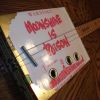Guide pins ??
17 posts
• Page 1 of 2 • 1, 2
Guide pins ??
Could someone tell me why guide pins are not allowed in proxy's and other kind of races ??? :think: :think:
- cyclone60
- HRW SlotCar Veteran!
- Posts: 126
- Joined: Sat Dec 27, 2014 7:35 am
- Location: St-Hubert QC Canada
-

MikeySlotCars - HRW SlotCar Veteran!
- Posts: 190
- Joined: Thu Oct 02, 2014 10:49 am
- Location: Montréal/Québec/Canada
Re: Guide pins ??
Folks hold proxy races and try to set a limited rule selection.
That may go against some ideas..
We have to understand that the ones holding the proxy races are doing this out of their own time and money.The rules set forth are to adjust the entrees to a select group of cars for the proxy.
Guys it is all for fun..
I've had a few proxy's and it can be get little deep on the rules..
What is fun is trying to build a car to enter the proxy..
Like I said ,let's not loose the fact that every one is in it for the fun.. :D
Rusty
That may go against some ideas..
We have to understand that the ones holding the proxy races are doing this out of their own time and money.The rules set forth are to adjust the entrees to a select group of cars for the proxy.
Guys it is all for fun..
I've had a few proxy's and it can be get little deep on the rules..
What is fun is trying to build a car to enter the proxy..
Like I said ,let's not loose the fact that every one is in it for the fun.. :D
Rusty
-

ourwayband - HRW SlotCar Veteran!
- Posts: 2471
- Joined: Wed Sep 05, 2012 12:10 pm
- Location: West Tennessee
Re: Guide pins ??
I would "guess" that there may be a concern about shorting / arcing across the rails with the guide pin set up when a car spins out?
That is the only reason I can think of - maybe someone with actual experience or that has required flag guides only can confirm if this is the case or not?
(With a flag the pick-up braids are held parallel to the rails / braid / tape - where with a pin the pick-up braids rotate with the car and if the car drifts far enough and the braids are long enough, they could result in a dead short across the rails, which may(?) cause issues?)
That is the only reason I can think of - maybe someone with actual experience or that has required flag guides only can confirm if this is the case or not?
(With a flag the pick-up braids are held parallel to the rails / braid / tape - where with a pin the pick-up braids rotate with the car and if the car drifts far enough and the braids are long enough, they could result in a dead short across the rails, which may(?) cause issues?)
-

TuscoTodd - HRW Bouncer
- Posts: 7145
- Joined: Sat Aug 17, 2013 11:25 am
- Location: Rural Ohio
Re: Guide pins ??
I am not sure but I would guess it would have something to do with drifting the back end out on No Mag cars, and routed slots vs plastic one. On my home track I notice the guide flag cars are much better at drifting as the brushes stay aligned with the rail. If anything I would see guide pins as having a disadvantage.
These opinions are based on the observations on my home track.
These opinions are based on the observations on my home track.
-

BARC 1 - HRW SlotCar Veteran!
- Posts: 2040
- Joined: Wed Dec 23, 2015 6:03 pm
- Location: NW Alberta
Re: Guide pins ??
The shorting / arcing across the rails is a major factor for some people. Replacing fuses every time a pin car spins out can make for a long day. The longer guide flags are a lot smoother in the slot than a pin, too. Any little rough spot on the side of the slot, especially in a curve, will catch the pin a little bit each time it goes by. After running a few races with a guide pin. that little rough spot can turn into a big rough spot pretty quickly. The flag spreads the side load out a little bit and is more forgiving than a pin, especially a metal pin! Both the fact that the flag is made of a fairly soft material and the fact that it is mounted with some flex helps reduce the wear and tear a bit. This is especially true on routed MDF tracks, as the slots can start to tear up pretty quickly. The last consideration that I can think of is deslots. That guide flag spreads the force of the car out a bit and usually has a fairly smooth bottom. I have seen heavy brass cars with metal pins leave a mark in the paint as they slide across the track. I have also seen a pin dig in and rip the copper tape while sliding through another lane. They can also play havoc with track braids when they slide over them. We used to have a couple of guys running steel pins on our (mostly plastic) club tracks , but after we started running on some routed tracks, they agreed to go to flags.
One last thought. If you have photoeyes mounted across the slot, you need the flag to count a lap. The pin will just fly through without triggering the lap counter! A few tracks actually rely upon the guide flag to break the beam.
One last thought. If you have photoeyes mounted across the slot, you need the flag to count a lap. The pin will just fly through without triggering the lap counter! A few tracks actually rely upon the guide flag to break the beam.
- DManley
- Posts: 79
- Joined: Wed May 28, 2014 10:32 am
- Location: Houghton Lake MI
Re: Guide pins ??
i can tell you why I put this in the set of rules for the ProNoMag. This is for no magnet 1/43rd racing!
cars with guide pins tend to spin and short out. I have to get to the car and place it in the slot again. If i overdrive a car with rotating guide, it will go and not stop.
i´ve driven to many cars with guide pins. For me, it is no fun always having to place the car in the slot again. i want to drive the cars and not always place them in the slot again. It is simply coming from experience.
Peter
cars with guide pins tend to spin and short out. I have to get to the car and place it in the slot again. If i overdrive a car with rotating guide, it will go and not stop.
i´ve driven to many cars with guide pins. For me, it is no fun always having to place the car in the slot again. i want to drive the cars and not always place them in the slot again. It is simply coming from experience.
Peter
-

pfuetze - HRW SlotCar Veteran!
- Posts: 2255
- Joined: Wed Sep 05, 2012 11:35 pm
- Location: Austria
Re: Guide pins ??
Thank you all for your answers and your comments :text-thankyouyellow:
Let's keep having fun with this hobby :music-rockout: :music-rockout:
Let's keep having fun with this hobby :music-rockout: :music-rockout:
- cyclone60
- HRW SlotCar Veteran!
- Posts: 126
- Joined: Sat Dec 27, 2014 7:35 am
- Location: St-Hubert QC Canada
Re: Guide pins ??
I agree with Peter when racing without magnets, but with mags we found a good shape for the pins after some trimming that allows the cars to drift and slide like a car with a guide flag and stop before it shorts the rails. Took a lot of pins to figure it out, but for 2 bucks a bag it has been worth it! Used to hate the Go cars, but now that we made them fun they're awesome.
But hey, different strokes for different folks!
But hey, different strokes for different folks!
-

dc6287 - HRW SlotCar Veteran!
- Posts: 116
- Joined: Thu Sep 06, 2012 1:31 pm
- Location: Chillinois
-

ourwayband - HRW SlotCar Veteran!
- Posts: 2471
- Joined: Wed Sep 05, 2012 12:10 pm
- Location: West Tennessee
Re: Guide pins ??
You can usually prevent the short circuit situation on a Carrera GO slot car when racing without the tracton magnet, if you shorten the trailing braid.
Best regards,
Brian
Best regards,
Brian
-

BRS Hobbies - HRW SlotCar Veteran!
- Posts: 500
- Joined: Thu Sep 06, 2012 11:49 am
- Location: Ohio
Re: Guide pins ??
Guys...I`ve been messing with these ARTINs quite a few years and I can honestly say that ..I`VE NEVER HAD ONE SHORT OUT THE TRACK....now I`m not saying its not possible,but it`s never happened to me!
-

OldDogMotorsports - HRW SlotCar Veteran!
- Posts: 1285
- Joined: Sun Sep 09, 2012 5:38 am
- Location: FL.IN.KY. FLINKY?
Re: Guide pins ??
Hoos, you´re goind to say that NEVER a car spun by 90° and stopped moving?
i do not think so.
or did you always shoot them into the stratosphere when deslotting ;) LOL
i do not think so.
or did you always shoot them into the stratosphere when deslotting ;) LOL
-

pfuetze - HRW SlotCar Veteran!
- Posts: 2255
- Joined: Wed Sep 05, 2012 11:35 pm
- Location: Austria
-

OldDogMotorsports - HRW SlotCar Veteran!
- Posts: 1285
- Joined: Sun Sep 09, 2012 5:38 am
- Location: FL.IN.KY. FLINKY?
17 posts
• Page 1 of 2 • 1, 2
Who is online
Users browsing this forum: No registered users and 2 guests
